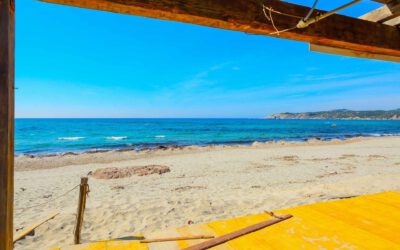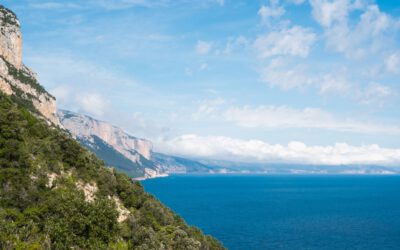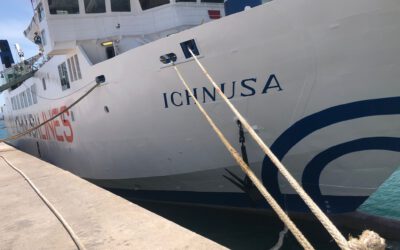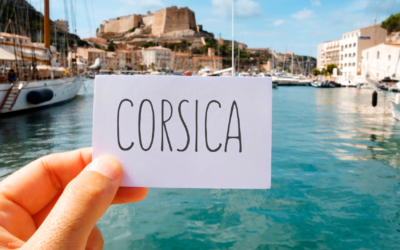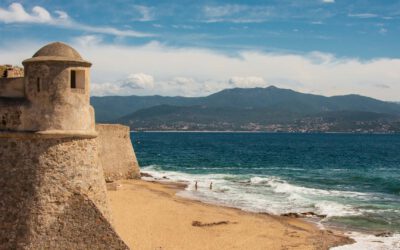Bonifacio
Jewel of the Mediterranean
Often called the Corsican Gibraltar, though any description you make of this famous town perched atop white limestone cliffs will never capture the charm it diffuses when you find yourself immersed in its narrow streets. Difficult to grasp it in its entirety, there is however a unique observation point to see it in all its splendour, which is from the deck of a ship… the most enchanting view in the world, a jewel that shines from the bottom of a fjord of white cliffs, sculpted by the wind and the sea.
If you are planning a short visit to Bonifacio, then you are already in the right place. Look out and enjoy the view, and we’ll take care of telling you some little secrets of this place!

A Genoese Colony
As soon as you dive into it, something sounds familiar in the locals’ speech even if it is difficult to understand what that is. Only the Genoese will be able to touch on the secret, the only ones who will recognize some words in the Corsican dialect derived from their own chanting style of speech. This is the result of a long period of domination of the seafaring city, which began in 1187 when – it is said – the Genoese stole it from the Marquis Bonifacio II of Tuscany, Lord of Lucca, taking advantage of the fact that all its inhabitants were busy drinking at a wedding banquet.
Bonifacio became the residence of many Ligurian settlers, encouraged to move there by the considerable fiscal advantages that the Republic promised them in order to expel the native population and to establish Genoese customs and traditions.
The colony was threatened twice in the course of its history: the first in 1420 when Pope Boniface VIII decided to assign it to Spain and therefore giving an excellent pretext to Alfonso V of Aragon to besiege it for months before the Genoese were able to free it once and for all after calling for reinforcements.
La Superba (as Genoa is also known) had a hard time here again a hundred years later, in 1553, but this time it was not a Pope but a Corsican partisan, Sampiero, who threatened the balance of power, and in an attempt to free the island from Genoese domination, he called both the French and the Turkish privateer Dragut to help. That time, things did not go very well for the Republic, the city capitulated and only got the island back after the treaty of Cateau-Cambréis in 1559. They remained there until the Treaty of Versailles in 1768, which permanently attributed it to France.
Entertaining Fact: was Ulysses in Bonifacio?
Ulysses (or Odysseus) was the Greek hero who conquered Troy, hiding inside the wooden horse which was then dragged inside the walls by the Trojans.
The Greek poet Homer, in the epic poem the Odyssey, told of his many adventures on the journey that brought him back to Ithaca, his birthplace, sailing around the unexplored Mediterranean. A fictional tale, certainly inspired by many frightening and extravagant tales from ancient sailors returning from their explorations of the then unknown Mediterranean Sea.
For historians, trying to identify the places where Homer set Ulysses’ adventures has always been a pleasant challenge, and there has always been a race among tourist resorts to claim the authorship of certain scenes. Bonifacio also has its own and it is said that it is here that Ulysses and his crew collided with the Laestrygonians, the man-eating giants who destroyed almost all of his fleet.
The port is beautiful and wide; sublime rocks
Circle it everywhere, and between two points,
That protrude out and meet each other,
A narrow mouth opens (…)
(The Odyssey, Book X)
Entertaining Fact: was Ulysses in Bonifacio?
Ulysses (or Odysseus) was the Greek hero who conquered Troy, hiding inside the wooden horse which was then dragged inside the walls by the Trojans.
The Greek poet Homer, in the epic poem the Odyssey, told of his many adventures on the journey that brought him back to Ithaca, his birthplace, sailing around the unexplored Mediterranean. A fictional tale, certainly inspired by many frightening and extravagant tales from ancient sailors returning from their explorations of the then unknown Mediterranean Sea.
For historians, trying to identify the places where Homer set Ulysses’ adventures has always been a pleasant challenge, and there has always been a race among tourist resorts to claim the authorship of certain scenes. Bonifacio also has its own and it is said that it is here that Ulysses and his crew collided with the Laestrygonians, the man-eating giants who destroyed almost all of his fleet.
The port is beautiful and wide; sublime rocks
Circle it everywhere, and between two points,
That protrude out and meet each other,
A narrow mouth opens (…)
(The Odyssey, Book X)
What to See in Bonifacio: a walking route among the secrets of the most fascinating Corsican town
Certainly the town of Bonifacio deserves a break from the wonderful beaches and archipelagos that surround it, for a visit strictly on foot.
Starting from the port, there are two stairs that go up to the highest and most panoramic point of Bonifacio: the citadel built by the Genoese. The first is called Montée Saint-Roch and leads up to the Porte de Gênes, passing in front of the small Chapel of Saint-Roch, where the last victim of the plague of 1528 died. In this area there is also the Church of Saint Erasmus, dedicated to the patron saint of fishermen.
The Porte de Gênes is equipped with a drawbridge and for a very long time it remained the only access to the citadel, until 1854 when the Porte de France was also built. Here, the Bastion de l’Etendard can be visited inside and houses the Mémorial du Passé Bonifacien which takes us directly to 1553, during the siege of the French and the Turks when the fortification was built. At the end of the visit you can admire a spectacular view of the Straits of Bonifacio from the two squares below the bastion: Place du Marchè and Place de la Manichella.
And here we are catapulted into the citadel, crossed by its main artery, Rue des Deux Empereurs. If you are wondering the reason for this extravagant name, here you are: both Charles V and Napoleon stayed here, respectively in 1541 for the expedition to Algiers and in 1793. The rooms that housed them still exist at numbers 4 and 7 but they can’t be visited and traces of their passage remain only thanks to two plaques affixed in memory of those dates.
The oldest building in the city has Pisan paternity, at the time of the foundation of Bonifacio when the Genoese had not yet set their hands on the small Corsican town. This is the Church of Saint Marie Majeure, open to the public for a short visit and a dip into the city’s past, when the nobles gathered under the arches of its beautiful loggia.
The problem of water supply for the Corsicans has always been a headache, evidenced by the municipal cistern in front of the church, built to store rainwater, but not only: even the Scala del Re D’Aragona (Staircase of the King of Aragon) has a lot to do with this story. Legend has it that it was built in just one night by Spanish troops during the siege of 1420, but many believe that it is more likely that it was created to access a source of water discovered by the Franciscan friars. The staircase is the most fascinating you can find on the island and is one of the most instagrammed places in Bonifacio. It can be visited during the public opening hours by purchasing an entrance ticket.
The journey through the discovery of this enchanting town does not end here and moving west there are two things that you cannot miss, the Church of Saint Dominique, one of the rare Gothic-style buildings on the island, and the Marine Cemetery, off any traditional tourist itinerary, where white buildings lie sheer above the sea, silent and solemn. A place where you can enjoy a breathtaking view and an surreal quiet.
Returning to the town, you pass in front of the memorial to the 695 victims of the sinking of the Semillante, a French frigate engaged in the Crimean War of 1855, which sank here crashing on the rocks west of Lavezzi, surprised by a storm while transporting French troops to Odessa.
Your visit to the magnificent Bonifacio ends here, but for those who still have some energy to spend, here is a final gem: stroll the walkway that follows the ancient fortifications, here you will find fantastic views of the “fjord” and the beautiful Bonifaccine beaches.
The journey through the discovery of this enchanting town does not end here and moving west there are two things that you cannot miss, the Church of Saint Dominique, one of the rare Gothic-style buildings on the island, and the Marine Cemetery, off any traditional tourist itinerary, where white buildings lie sheer above the sea, silent and solemn. A place where you can enjoy a breathtaking view and an surreal quiet.
Returning to the town, you pass in front of the memorial to the 695 victims of the sinking of the Semillante, a French frigate engaged in the Crimean War of 1855, which sank here crashing on the rocks west of Lavezzi, surprised by a storm while transporting French troops to Odessa.
Your visit to the magnificent Bonifacio ends here, but for those who still have some energy to spend, here is a final gem: stroll the walkway that follows the ancient fortifications, here you will find fantastic views of the “fjord” and the beautiful Bonifaccine beaches.
Around Bonifacio
This stretch of sea is one of the most beautiful and sought after places in the Mediterranean, if after having explored every hidden corner you still have time, energy and resources for a trip out of town and you are looking for an agency to organize a tour for you, on the pier of the marina you will be spoiled for choice.
The proposals are standard and very similar to each other, with two being the most popular: the first lasts about an hour and includes the fjord, the Madonnetta lighthouse, the Sdragonato cave and the Fazzio gully, while the second points straight towards the islands of the Lavezzi archipelago, where you can also spend the whole day. The return journey, slightly longer than the outward journey, runs along Ile Cavallo, Cap Sperone, the Sdragonato cave, some gullies and cliffs for a noteworthy conclusion!
Get inspired
The beaches not to be missed between Santa Teresa Gallura and Bonifacio
Sardinia and Corsica are among the largest islands in the Mediterranean, two real pearls and destinations sought after by thousands of tourists every year, renowned for their crystalline waters, unspoiled beaches and all the unforgettable experiences they offer, from...
Wild Blue
gliastra, on the eastern side of Sardinia, is synonymous with paradise. A sea of unique landscapes between aqua blue waters and spectacular cliffs, irresistible to both hikers and climbers. Mother nature’s variety takes us from the sea to the hills and right on up...
A Ferry Tale – The history of the ship Ichnusa
Who among us, when thinking of the sea, Sardinia, holidays and dolphins, does not immediately think of Tirrenia, the good old Italian state-owned company that for most of our lives was just about the only one ferrying passengers to those heavenly beaches? You might...
Three days in Corsica? Here is our itinerary.
Who says that beach holidays must necessarily be characterized by unbridled nightlife, crowded beaches and queues in the streets? In Corsica, there are many secluded spots where time moves slowly off the beaten track, far from the most popular tourist circuits. Do you...
All the information you need to travel between Sardinia and Corsica
You have already had your holiday in Sardinia booked for a few months, a long-awaited moment; now you are here, you are enjoying the sun, the sea, the relaxing holiday vibe, everything is perfect, and you could not wish for more. But what if I told you that, on the...
Interesting facts about Sardinia and Corsica
Sardinia and Corsica are among the largestislands in theMediterranean, two real pearls and destinations sought after by thousands of tourists every year for their renowned crystalline waters, untamed beaches, and all the unforgettable experiences they offer, from...

